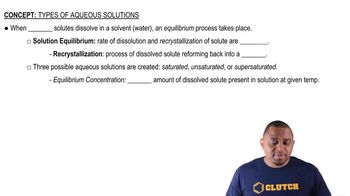Here are the essential concepts you must grasp in order to answer the question correctly.
Electrolysis
Electrolysis is a chemical process that uses electrical energy to drive a non-spontaneous reaction. In this process, an electric current is passed through an electrolyte, causing the decomposition of the compound. This technique is essential for extracting metals from their ores, particularly for active metals that cannot be easily reduced by chemical means.
Recommended video:
Molten Salts vs. Aqueous Solutions
Molten salts are ionic compounds that are heated until they become liquid, allowing ions to move freely. In contrast, aqueous solutions contain water as a solvent, which can introduce complications such as competing reactions with water. For active metals like aluminum, using molten salts prevents the formation of hydrogen gas and ensures a more efficient extraction process.
Recommended video:
Types of Aqueous Solutions
Reactivity of Active Metals
Active metals, such as aluminum, have a strong tendency to lose electrons and form positive ions. This high reactivity makes them difficult to extract using traditional methods, as they readily react with water and other substances. Electrolysis of molten salts allows for the direct reduction of these metals without interference from other reactions, making it a preferred method for their extraction.
Recommended video:
 Verified step by step guidance
Verified step by step guidance


